Project Portfolio & Program Management: Sustainability in Projects
VerifiedAdded on 2020/04/21
|15
|3218
|450
Project
AI Summary
This assignment delves into the critical aspects of project portfolio and program management, focusing on sustainability. It begins with an overview of portfolio evaluation, examining methods organizations use to assess project management, providing justifications for these methods, and addressing the challenges encountered, particularly in a global environment. The analysis includes the integration of the benefits management lifecycle to successfully meet deliverable goals. Furthermore, the assignment explores portfolio management strategies, ensuring alignment with strategic objectives, and the role of the project management office. It also covers quantitative and qualitative tools and techniques, maturity levels in portfolio management, and best practices for improvement. The document concludes with the process of implementing changes at a corporate level, emphasizing corporate culture and change management initiatives. The challenges in project portfolio management are also discussed, offering a comprehensive understanding of the topic. The assignment is a valuable resource for students studying leadership and management, providing insights into the complexities and best practices of project portfolio and program management.
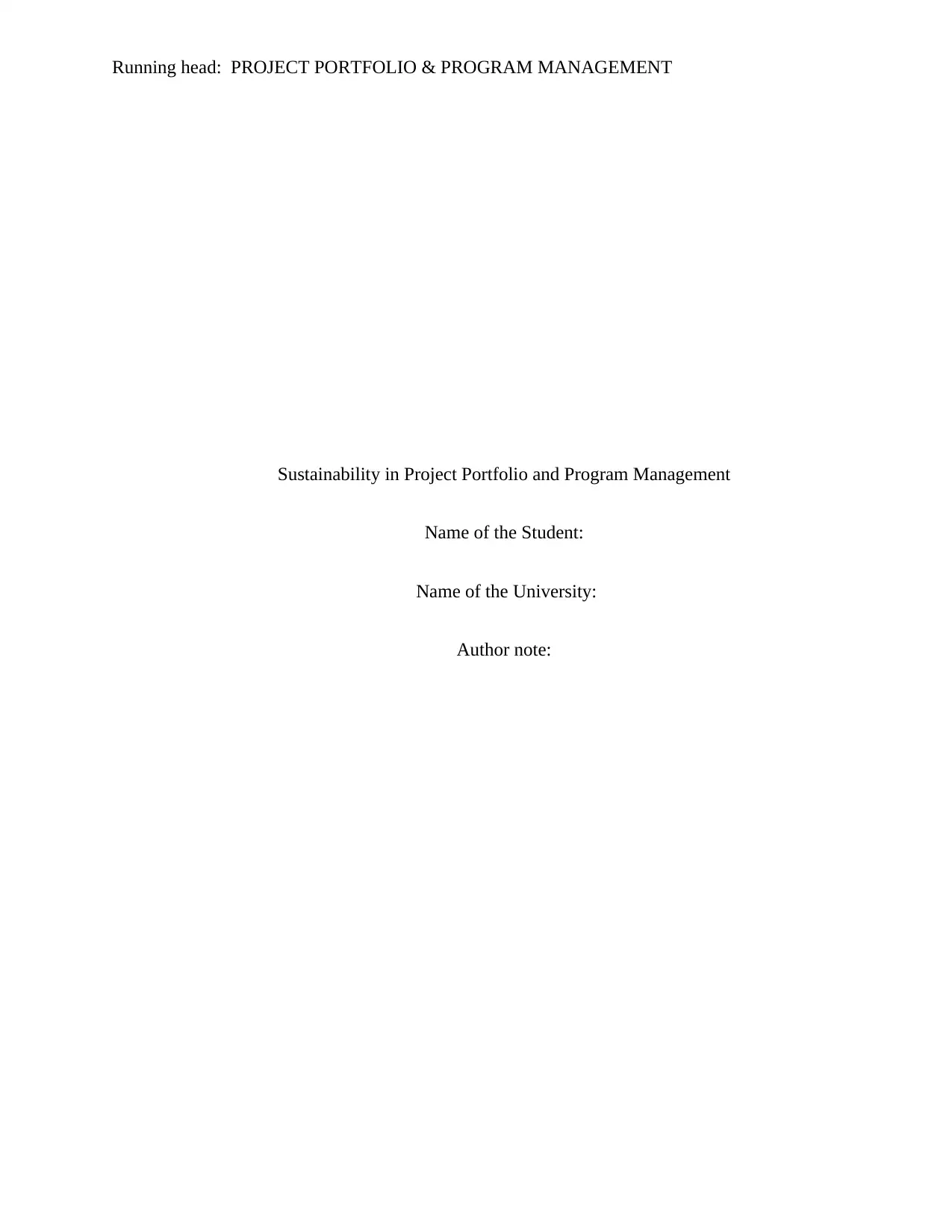
Running head: PROJECT PORTFOLIO & PROGRAM MANAGEMENT
Sustainability in Project Portfolio and Program Management
Name of the Student:
Name of the University:
Author note:
Sustainability in Project Portfolio and Program Management
Name of the Student:
Name of the University:
Author note:
Secure Best Marks with AI Grader
Need help grading? Try our AI Grader for instant feedback on your assignments.
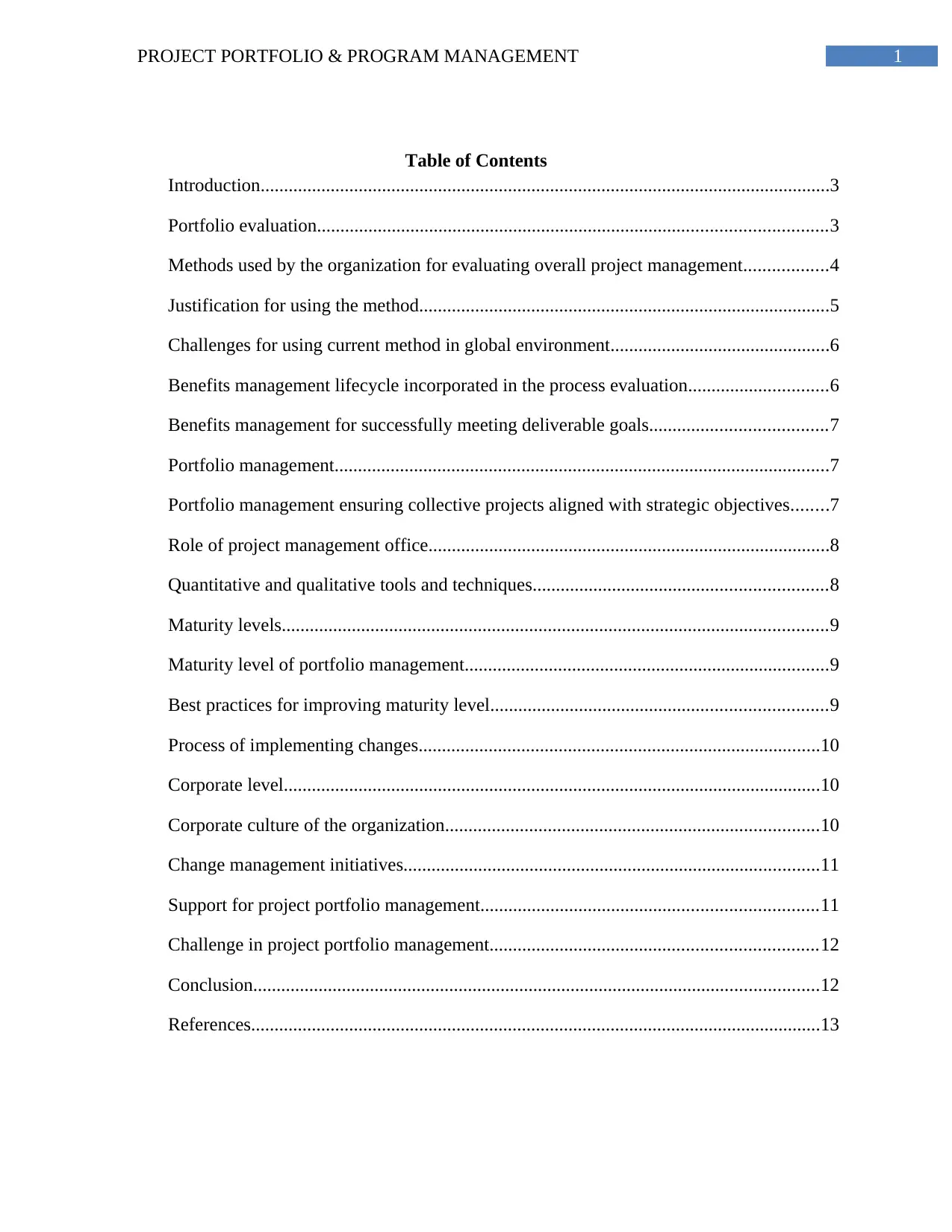
1PROJECT PORTFOLIO & PROGRAM MANAGEMENT
Table of Contents
Introduction..........................................................................................................................3
Portfolio evaluation.............................................................................................................3
Methods used by the organization for evaluating overall project management..................4
Justification for using the method........................................................................................5
Challenges for using current method in global environment...............................................6
Benefits management lifecycle incorporated in the process evaluation..............................6
Benefits management for successfully meeting deliverable goals......................................7
Portfolio management..........................................................................................................7
Portfolio management ensuring collective projects aligned with strategic objectives........7
Role of project management office......................................................................................8
Quantitative and qualitative tools and techniques...............................................................8
Maturity levels.....................................................................................................................9
Maturity level of portfolio management..............................................................................9
Best practices for improving maturity level........................................................................9
Process of implementing changes......................................................................................10
Corporate level...................................................................................................................10
Corporate culture of the organization................................................................................10
Change management initiatives.........................................................................................11
Support for project portfolio management........................................................................11
Challenge in project portfolio management......................................................................12
Conclusion.........................................................................................................................12
References..........................................................................................................................13
Table of Contents
Introduction..........................................................................................................................3
Portfolio evaluation.............................................................................................................3
Methods used by the organization for evaluating overall project management..................4
Justification for using the method........................................................................................5
Challenges for using current method in global environment...............................................6
Benefits management lifecycle incorporated in the process evaluation..............................6
Benefits management for successfully meeting deliverable goals......................................7
Portfolio management..........................................................................................................7
Portfolio management ensuring collective projects aligned with strategic objectives........7
Role of project management office......................................................................................8
Quantitative and qualitative tools and techniques...............................................................8
Maturity levels.....................................................................................................................9
Maturity level of portfolio management..............................................................................9
Best practices for improving maturity level........................................................................9
Process of implementing changes......................................................................................10
Corporate level...................................................................................................................10
Corporate culture of the organization................................................................................10
Change management initiatives.........................................................................................11
Support for project portfolio management........................................................................11
Challenge in project portfolio management......................................................................12
Conclusion.........................................................................................................................12
References..........................................................................................................................13
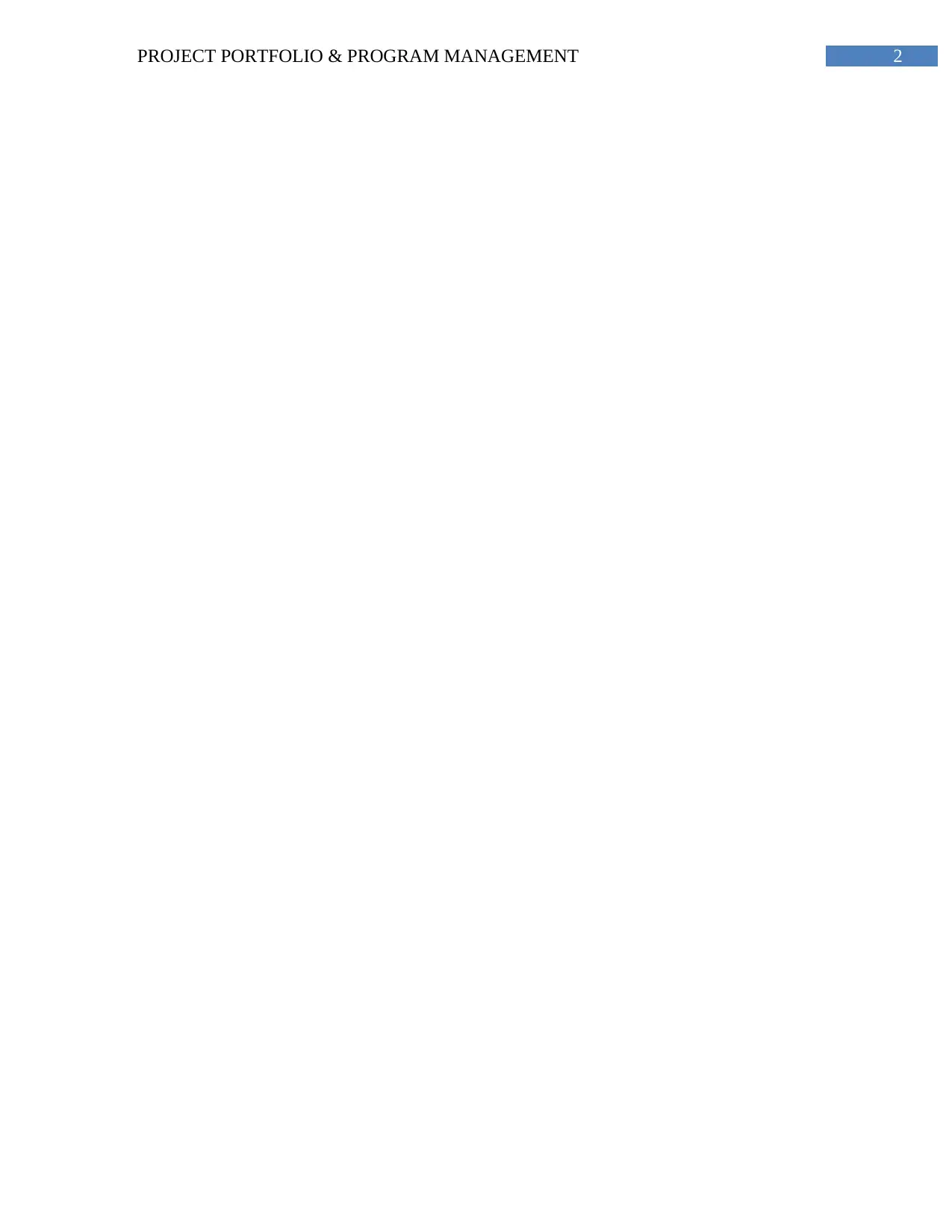
2PROJECT PORTFOLIO & PROGRAM MANAGEMENT
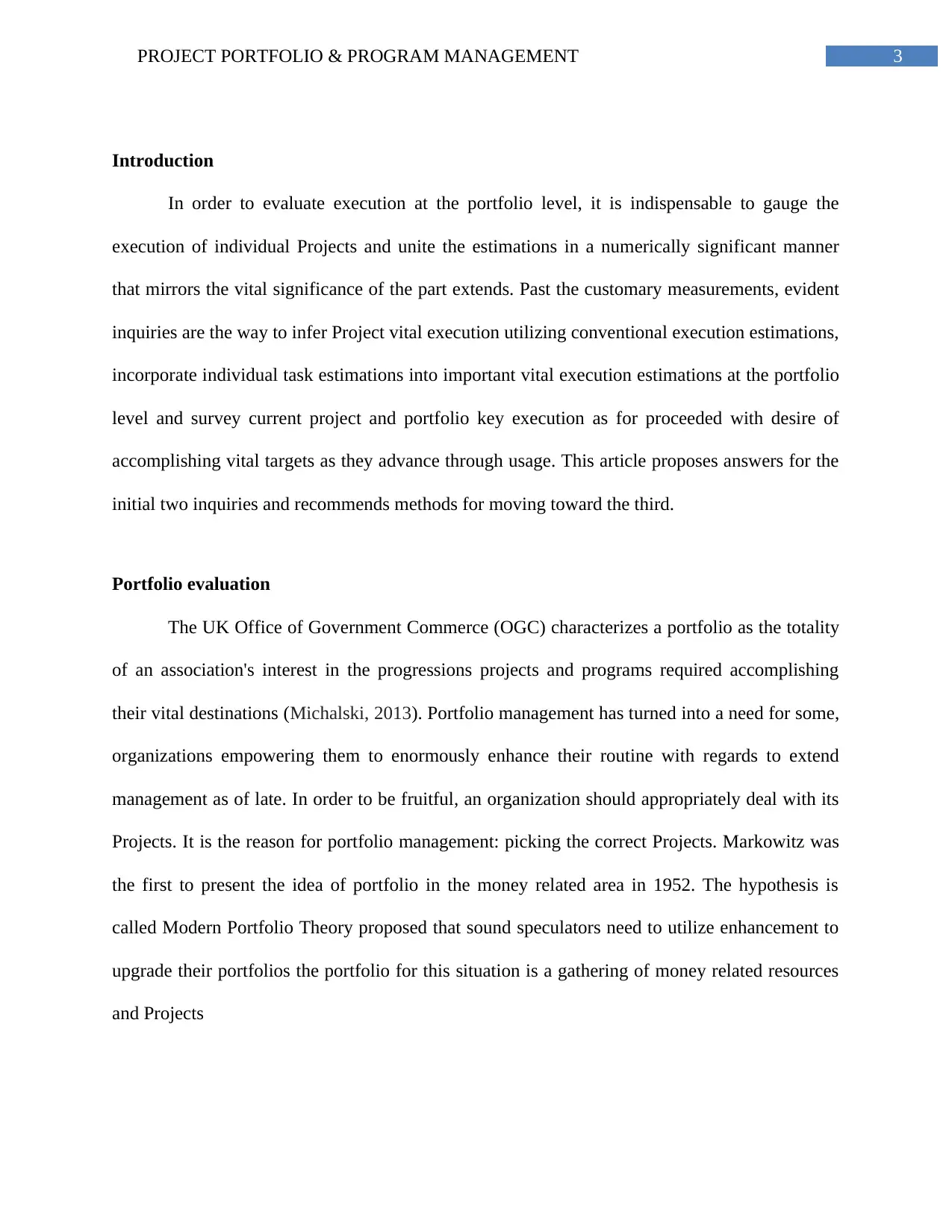
3PROJECT PORTFOLIO & PROGRAM MANAGEMENT
Introduction
In order to evaluate execution at the portfolio level, it is indispensable to gauge the
execution of individual Projects and unite the estimations in a numerically significant manner
that mirrors the vital significance of the part extends. Past the customary measurements, evident
inquiries are the way to infer Project vital execution utilizing conventional execution estimations,
incorporate individual task estimations into important vital execution estimations at the portfolio
level and survey current project and portfolio key execution as for proceeded with desire of
accomplishing vital targets as they advance through usage. This article proposes answers for the
initial two inquiries and recommends methods for moving toward the third.
Portfolio evaluation
The UK Office of Government Commerce (OGC) characterizes a portfolio as the totality
of an association's interest in the progressions projects and programs required accomplishing
their vital destinations (Michalski, 2013). Portfolio management has turned into a need for some,
organizations empowering them to enormously enhance their routine with regards to extend
management as of late. In order to be fruitful, an organization should appropriately deal with its
Projects. It is the reason for portfolio management: picking the correct Projects. Markowitz was
the first to present the idea of portfolio in the money related area in 1952. The hypothesis is
called Modern Portfolio Theory proposed that sound speculators need to utilize enhancement to
upgrade their portfolios the portfolio for this situation is a gathering of money related resources
and Projects
Introduction
In order to evaluate execution at the portfolio level, it is indispensable to gauge the
execution of individual Projects and unite the estimations in a numerically significant manner
that mirrors the vital significance of the part extends. Past the customary measurements, evident
inquiries are the way to infer Project vital execution utilizing conventional execution estimations,
incorporate individual task estimations into important vital execution estimations at the portfolio
level and survey current project and portfolio key execution as for proceeded with desire of
accomplishing vital targets as they advance through usage. This article proposes answers for the
initial two inquiries and recommends methods for moving toward the third.
Portfolio evaluation
The UK Office of Government Commerce (OGC) characterizes a portfolio as the totality
of an association's interest in the progressions projects and programs required accomplishing
their vital destinations (Michalski, 2013). Portfolio management has turned into a need for some,
organizations empowering them to enormously enhance their routine with regards to extend
management as of late. In order to be fruitful, an organization should appropriately deal with its
Projects. It is the reason for portfolio management: picking the correct Projects. Markowitz was
the first to present the idea of portfolio in the money related area in 1952. The hypothesis is
called Modern Portfolio Theory proposed that sound speculators need to utilize enhancement to
upgrade their portfolios the portfolio for this situation is a gathering of money related resources
and Projects
Secure Best Marks with AI Grader
Need help grading? Try our AI Grader for instant feedback on your assignments.
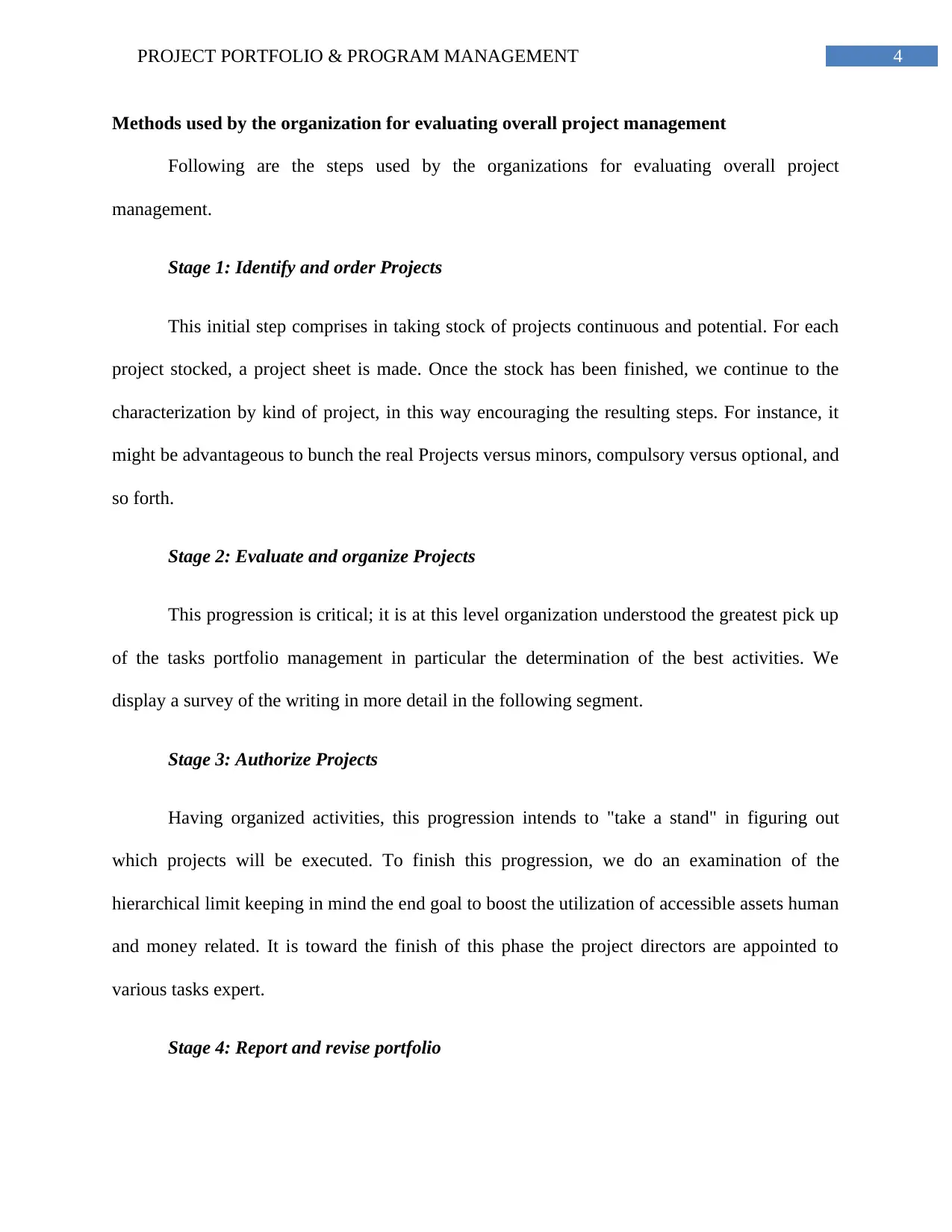
4PROJECT PORTFOLIO & PROGRAM MANAGEMENT
Methods used by the organization for evaluating overall project management
Following are the steps used by the organizations for evaluating overall project
management.
Stage 1: Identify and order Projects
This initial step comprises in taking stock of projects continuous and potential. For each
project stocked, a project sheet is made. Once the stock has been finished, we continue to the
characterization by kind of project, in this way encouraging the resulting steps. For instance, it
might be advantageous to bunch the real Projects versus minors, compulsory versus optional, and
so forth.
Stage 2: Evaluate and organize Projects
This progression is critical; it is at this level organization understood the greatest pick up
of the tasks portfolio management in particular the determination of the best activities. We
display a survey of the writing in more detail in the following segment.
Stage 3: Authorize Projects
Having organized activities, this progression intends to "take a stand" in figuring out
which projects will be executed. To finish this progression, we do an examination of the
hierarchical limit keeping in mind the end goal to boost the utilization of accessible assets human
and money related. It is toward the finish of this phase the project directors are appointed to
various tasks expert.
Stage 4: Report and revise portfolio
Methods used by the organization for evaluating overall project management
Following are the steps used by the organizations for evaluating overall project
management.
Stage 1: Identify and order Projects
This initial step comprises in taking stock of projects continuous and potential. For each
project stocked, a project sheet is made. Once the stock has been finished, we continue to the
characterization by kind of project, in this way encouraging the resulting steps. For instance, it
might be advantageous to bunch the real Projects versus minors, compulsory versus optional, and
so forth.
Stage 2: Evaluate and organize Projects
This progression is critical; it is at this level organization understood the greatest pick up
of the tasks portfolio management in particular the determination of the best activities. We
display a survey of the writing in more detail in the following segment.
Stage 3: Authorize Projects
Having organized activities, this progression intends to "take a stand" in figuring out
which projects will be executed. To finish this progression, we do an examination of the
hierarchical limit keeping in mind the end goal to boost the utilization of accessible assets human
and money related. It is toward the finish of this phase the project directors are appointed to
various tasks expert.
Stage 4: Report and revise portfolio
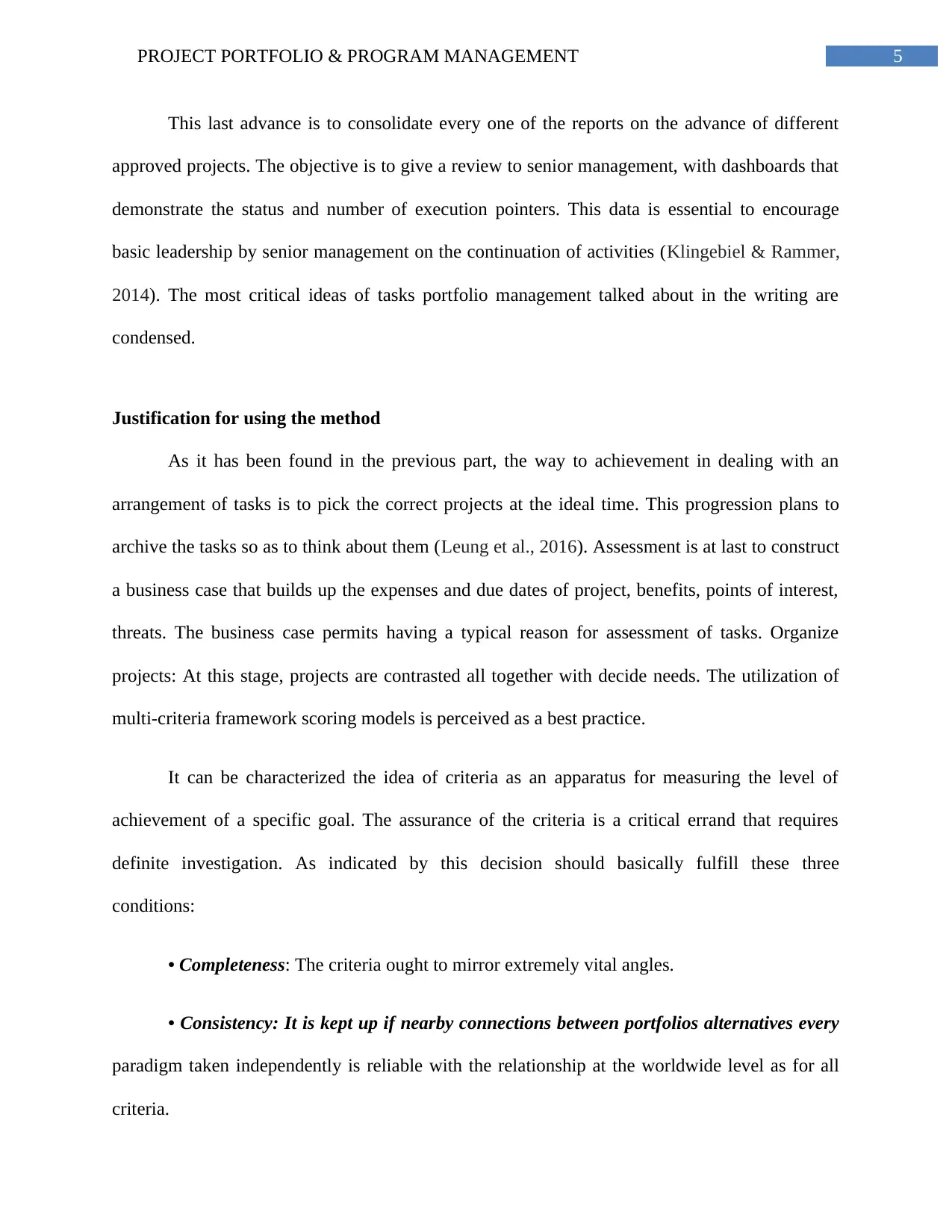
5PROJECT PORTFOLIO & PROGRAM MANAGEMENT
This last advance is to consolidate every one of the reports on the advance of different
approved projects. The objective is to give a review to senior management, with dashboards that
demonstrate the status and number of execution pointers. This data is essential to encourage
basic leadership by senior management on the continuation of activities (Klingebiel & Rammer,
2014). The most critical ideas of tasks portfolio management talked about in the writing are
condensed.
Justification for using the method
As it has been found in the previous part, the way to achievement in dealing with an
arrangement of tasks is to pick the correct projects at the ideal time. This progression plans to
archive the tasks so as to think about them (Leung et al., 2016). Assessment is at last to construct
a business case that builds up the expenses and due dates of project, benefits, points of interest,
threats. The business case permits having a typical reason for assessment of tasks. Organize
projects: At this stage, projects are contrasted all together with decide needs. The utilization of
multi-criteria framework scoring models is perceived as a best practice.
It can be characterized the idea of criteria as an apparatus for measuring the level of
achievement of a specific goal. The assurance of the criteria is a critical errand that requires
definite investigation. As indicated by this decision should basically fulfill these three
conditions:
• Completeness: The criteria ought to mirror extremely vital angles.
• Consistency: It is kept up if nearby connections between portfolios alternatives every
paradigm taken independently is reliable with the relationship at the worldwide level as for all
criteria.
This last advance is to consolidate every one of the reports on the advance of different
approved projects. The objective is to give a review to senior management, with dashboards that
demonstrate the status and number of execution pointers. This data is essential to encourage
basic leadership by senior management on the continuation of activities (Klingebiel & Rammer,
2014). The most critical ideas of tasks portfolio management talked about in the writing are
condensed.
Justification for using the method
As it has been found in the previous part, the way to achievement in dealing with an
arrangement of tasks is to pick the correct projects at the ideal time. This progression plans to
archive the tasks so as to think about them (Leung et al., 2016). Assessment is at last to construct
a business case that builds up the expenses and due dates of project, benefits, points of interest,
threats. The business case permits having a typical reason for assessment of tasks. Organize
projects: At this stage, projects are contrasted all together with decide needs. The utilization of
multi-criteria framework scoring models is perceived as a best practice.
It can be characterized the idea of criteria as an apparatus for measuring the level of
achievement of a specific goal. The assurance of the criteria is a critical errand that requires
definite investigation. As indicated by this decision should basically fulfill these three
conditions:
• Completeness: The criteria ought to mirror extremely vital angles.
• Consistency: It is kept up if nearby connections between portfolios alternatives every
paradigm taken independently is reliable with the relationship at the worldwide level as for all
criteria.
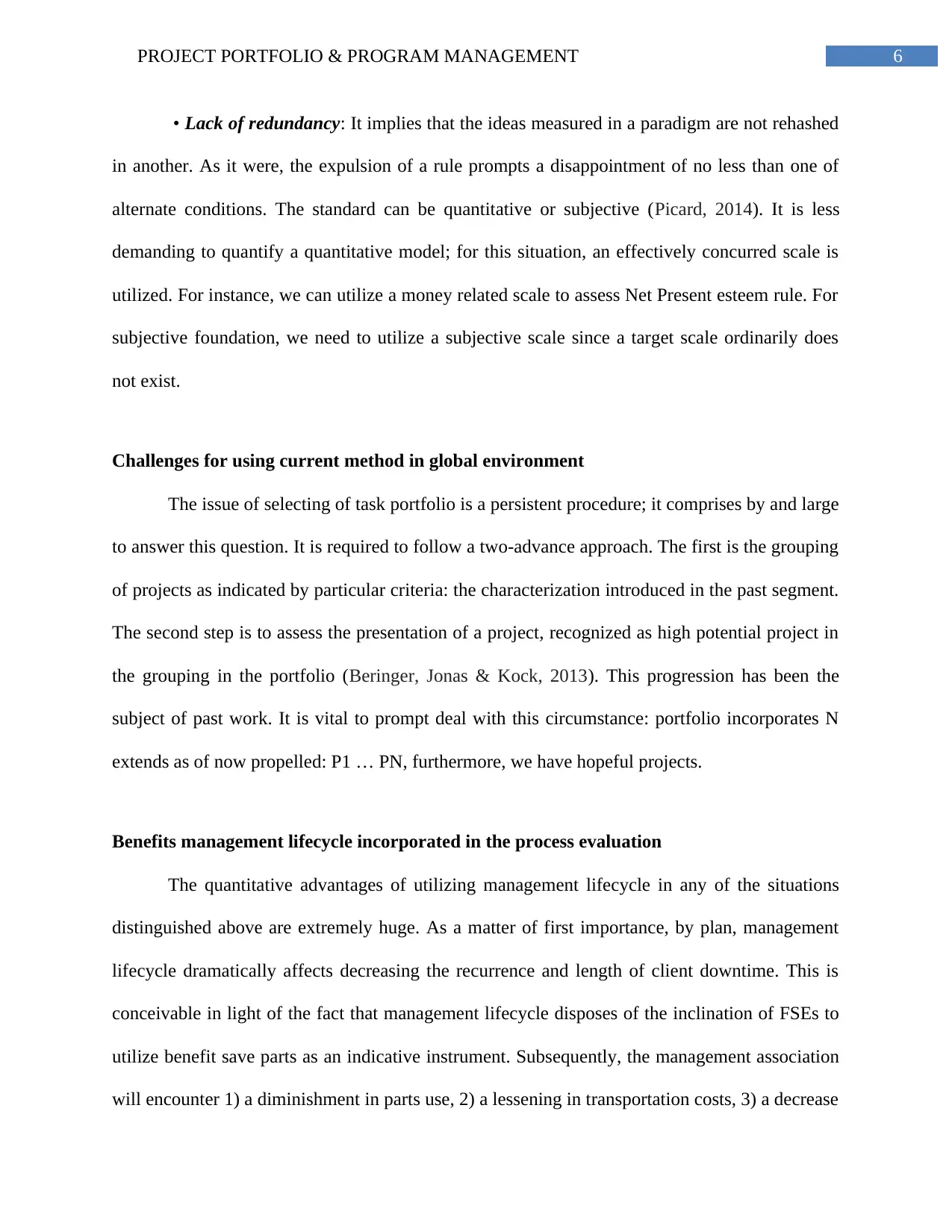
6PROJECT PORTFOLIO & PROGRAM MANAGEMENT
• Lack of redundancy: It implies that the ideas measured in a paradigm are not rehashed
in another. As it were, the expulsion of a rule prompts a disappointment of no less than one of
alternate conditions. The standard can be quantitative or subjective (Picard, 2014). It is less
demanding to quantify a quantitative model; for this situation, an effectively concurred scale is
utilized. For instance, we can utilize a money related scale to assess Net Present esteem rule. For
subjective foundation, we need to utilize a subjective scale since a target scale ordinarily does
not exist.
Challenges for using current method in global environment
The issue of selecting of task portfolio is a persistent procedure; it comprises by and large
to answer this question. It is required to follow a two-advance approach. The first is the grouping
of projects as indicated by particular criteria: the characterization introduced in the past segment.
The second step is to assess the presentation of a project, recognized as high potential project in
the grouping in the portfolio (Beringer, Jonas & Kock, 2013). This progression has been the
subject of past work. It is vital to prompt deal with this circumstance: portfolio incorporates N
extends as of now propelled: P1 … PN, furthermore, we have hopeful projects.
Benefits management lifecycle incorporated in the process evaluation
The quantitative advantages of utilizing management lifecycle in any of the situations
distinguished above are extremely huge. As a matter of first importance, by plan, management
lifecycle dramatically affects decreasing the recurrence and length of client downtime. This is
conceivable in light of the fact that management lifecycle disposes of the inclination of FSEs to
utilize benefit save parts as an indicative instrument. Subsequently, the management association
will encounter 1) a diminishment in parts use, 2) a lessening in transportation costs, 3) a decrease
• Lack of redundancy: It implies that the ideas measured in a paradigm are not rehashed
in another. As it were, the expulsion of a rule prompts a disappointment of no less than one of
alternate conditions. The standard can be quantitative or subjective (Picard, 2014). It is less
demanding to quantify a quantitative model; for this situation, an effectively concurred scale is
utilized. For instance, we can utilize a money related scale to assess Net Present esteem rule. For
subjective foundation, we need to utilize a subjective scale since a target scale ordinarily does
not exist.
Challenges for using current method in global environment
The issue of selecting of task portfolio is a persistent procedure; it comprises by and large
to answer this question. It is required to follow a two-advance approach. The first is the grouping
of projects as indicated by particular criteria: the characterization introduced in the past segment.
The second step is to assess the presentation of a project, recognized as high potential project in
the grouping in the portfolio (Beringer, Jonas & Kock, 2013). This progression has been the
subject of past work. It is vital to prompt deal with this circumstance: portfolio incorporates N
extends as of now propelled: P1 … PN, furthermore, we have hopeful projects.
Benefits management lifecycle incorporated in the process evaluation
The quantitative advantages of utilizing management lifecycle in any of the situations
distinguished above are extremely huge. As a matter of first importance, by plan, management
lifecycle dramatically affects decreasing the recurrence and length of client downtime. This is
conceivable in light of the fact that management lifecycle disposes of the inclination of FSEs to
utilize benefit save parts as an indicative instrument. Subsequently, the management association
will encounter 1) a diminishment in parts use, 2) a lessening in transportation costs, 3) a decrease
Paraphrase This Document
Need a fresh take? Get an instant paraphrase of this document with our AI Paraphraser
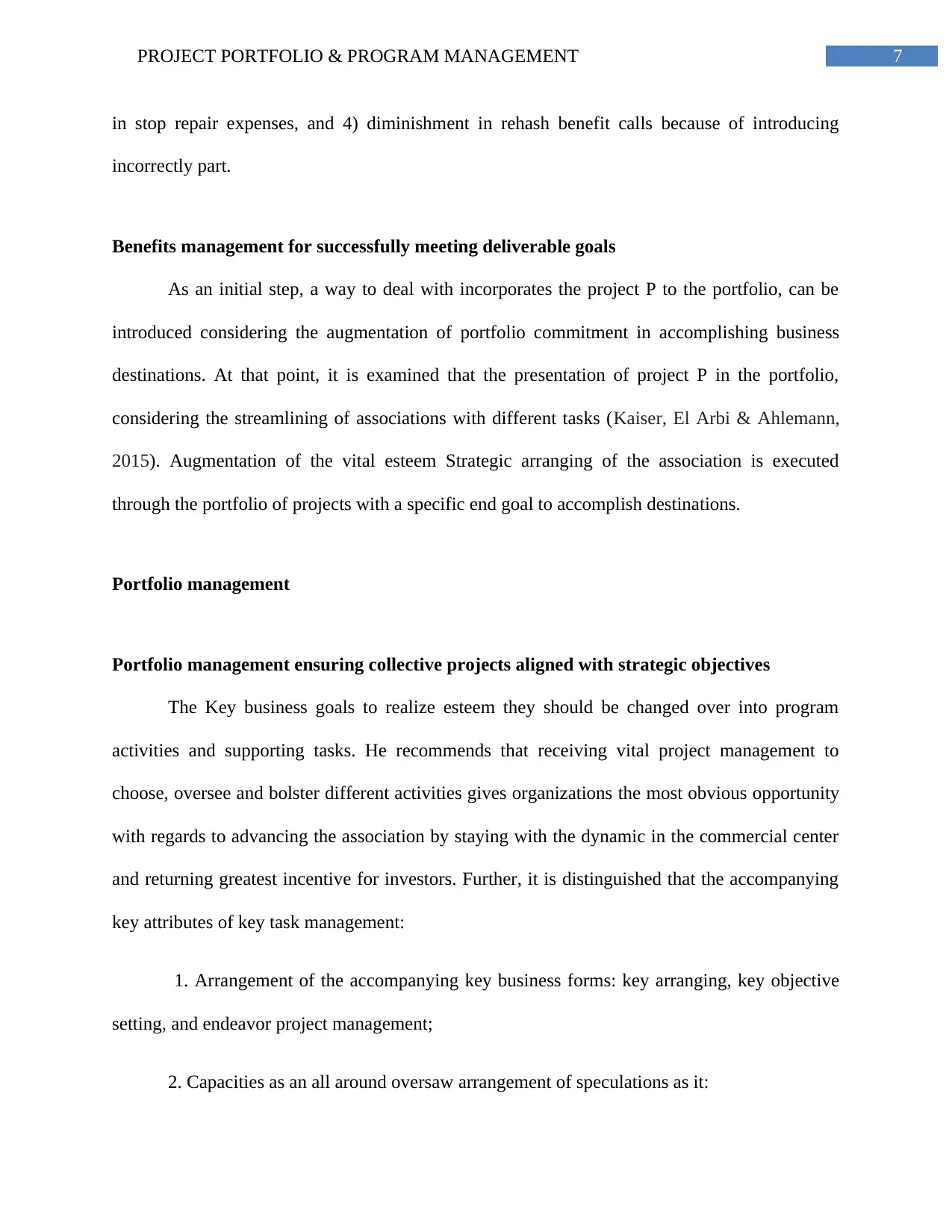
7PROJECT PORTFOLIO & PROGRAM MANAGEMENT
in stop repair expenses, and 4) diminishment in rehash benefit calls because of introducing
incorrectly part.
Benefits management for successfully meeting deliverable goals
As an initial step, a way to deal with incorporates the project P to the portfolio, can be
introduced considering the augmentation of portfolio commitment in accomplishing business
destinations. At that point, it is examined that the presentation of project P in the portfolio,
considering the streamlining of associations with different tasks (Kaiser, El Arbi & Ahlemann,
2015). Augmentation of the vital esteem Strategic arranging of the association is executed
through the portfolio of projects with a specific end goal to accomplish destinations.
Portfolio management
Portfolio management ensuring collective projects aligned with strategic objectives
The Key business goals to realize esteem they should be changed over into program
activities and supporting tasks. He recommends that receiving vital project management to
choose, oversee and bolster different activities gives organizations the most obvious opportunity
with regards to advancing the association by staying with the dynamic in the commercial center
and returning greatest incentive for investors. Further, it is distinguished that the accompanying
key attributes of key task management:
1. Arrangement of the accompanying key business forms: key arranging, key objective
setting, and endeavor project management;
2. Capacities as an all around oversaw arrangement of speculations as it:
in stop repair expenses, and 4) diminishment in rehash benefit calls because of introducing
incorrectly part.
Benefits management for successfully meeting deliverable goals
As an initial step, a way to deal with incorporates the project P to the portfolio, can be
introduced considering the augmentation of portfolio commitment in accomplishing business
destinations. At that point, it is examined that the presentation of project P in the portfolio,
considering the streamlining of associations with different tasks (Kaiser, El Arbi & Ahlemann,
2015). Augmentation of the vital esteem Strategic arranging of the association is executed
through the portfolio of projects with a specific end goal to accomplish destinations.
Portfolio management
Portfolio management ensuring collective projects aligned with strategic objectives
The Key business goals to realize esteem they should be changed over into program
activities and supporting tasks. He recommends that receiving vital project management to
choose, oversee and bolster different activities gives organizations the most obvious opportunity
with regards to advancing the association by staying with the dynamic in the commercial center
and returning greatest incentive for investors. Further, it is distinguished that the accompanying
key attributes of key task management:
1. Arrangement of the accompanying key business forms: key arranging, key objective
setting, and endeavor project management;
2. Capacities as an all around oversaw arrangement of speculations as it:
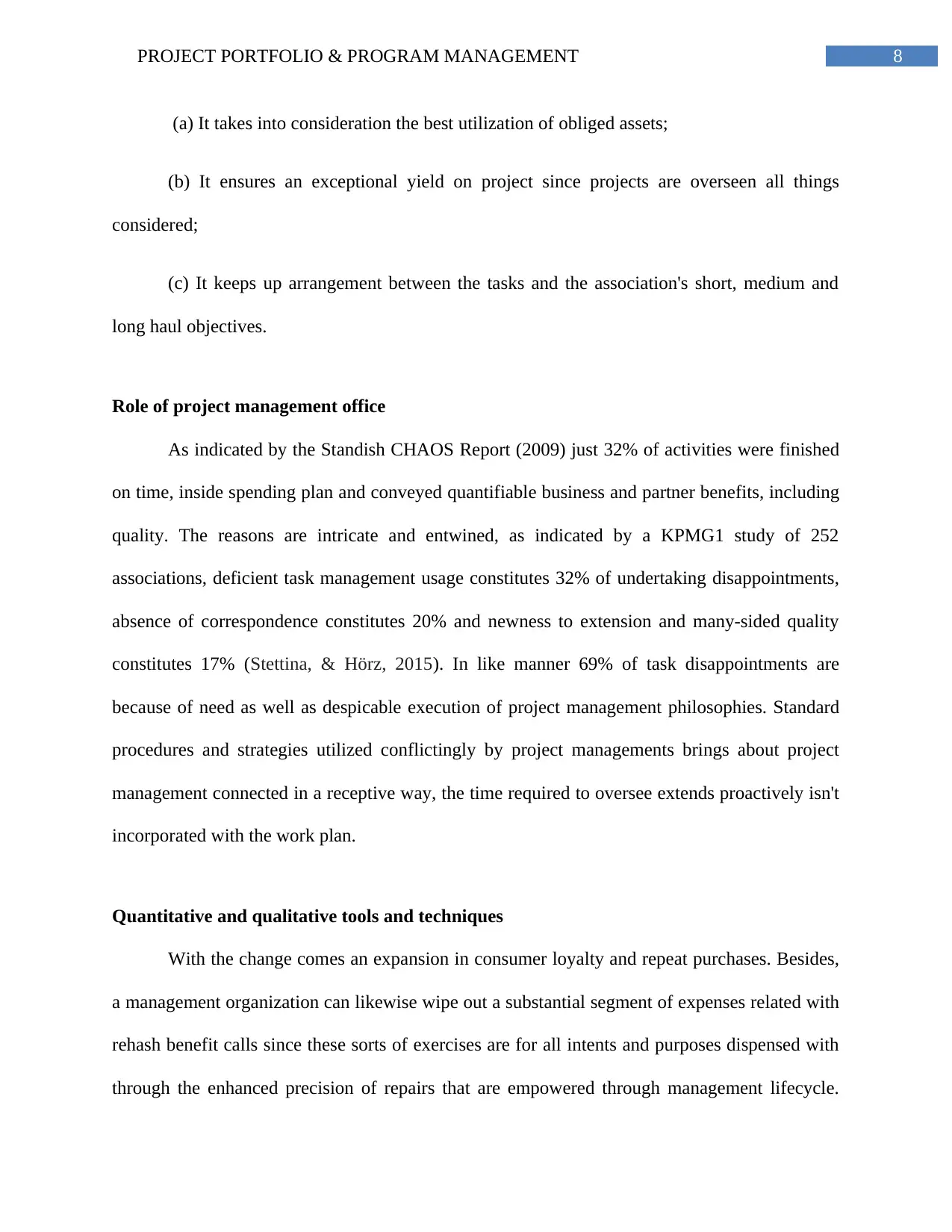
8PROJECT PORTFOLIO & PROGRAM MANAGEMENT
(a) It takes into consideration the best utilization of obliged assets;
(b) It ensures an exceptional yield on project since projects are overseen all things
considered;
(c) It keeps up arrangement between the tasks and the association's short, medium and
long haul objectives.
Role of project management office
As indicated by the Standish CHAOS Report (2009) just 32% of activities were finished
on time, inside spending plan and conveyed quantifiable business and partner benefits, including
quality. The reasons are intricate and entwined, as indicated by a KPMG1 study of 252
associations, deficient task management usage constitutes 32% of undertaking disappointments,
absence of correspondence constitutes 20% and newness to extension and many-sided quality
constitutes 17% (Stettina, & Hörz, 2015). In like manner 69% of task disappointments are
because of need as well as despicable execution of project management philosophies. Standard
procedures and strategies utilized conflictingly by project managements brings about project
management connected in a receptive way, the time required to oversee extends proactively isn't
incorporated with the work plan.
Quantitative and qualitative tools and techniques
With the change comes an expansion in consumer loyalty and repeat purchases. Besides,
a management organization can likewise wipe out a substantial segment of expenses related with
rehash benefit calls since these sorts of exercises are for all intents and purposes dispensed with
through the enhanced precision of repairs that are empowered through management lifecycle.
(a) It takes into consideration the best utilization of obliged assets;
(b) It ensures an exceptional yield on project since projects are overseen all things
considered;
(c) It keeps up arrangement between the tasks and the association's short, medium and
long haul objectives.
Role of project management office
As indicated by the Standish CHAOS Report (2009) just 32% of activities were finished
on time, inside spending plan and conveyed quantifiable business and partner benefits, including
quality. The reasons are intricate and entwined, as indicated by a KPMG1 study of 252
associations, deficient task management usage constitutes 32% of undertaking disappointments,
absence of correspondence constitutes 20% and newness to extension and many-sided quality
constitutes 17% (Stettina, & Hörz, 2015). In like manner 69% of task disappointments are
because of need as well as despicable execution of project management philosophies. Standard
procedures and strategies utilized conflictingly by project managements brings about project
management connected in a receptive way, the time required to oversee extends proactively isn't
incorporated with the work plan.
Quantitative and qualitative tools and techniques
With the change comes an expansion in consumer loyalty and repeat purchases. Besides,
a management organization can likewise wipe out a substantial segment of expenses related with
rehash benefit calls since these sorts of exercises are for all intents and purposes dispensed with
through the enhanced precision of repairs that are empowered through management lifecycle.
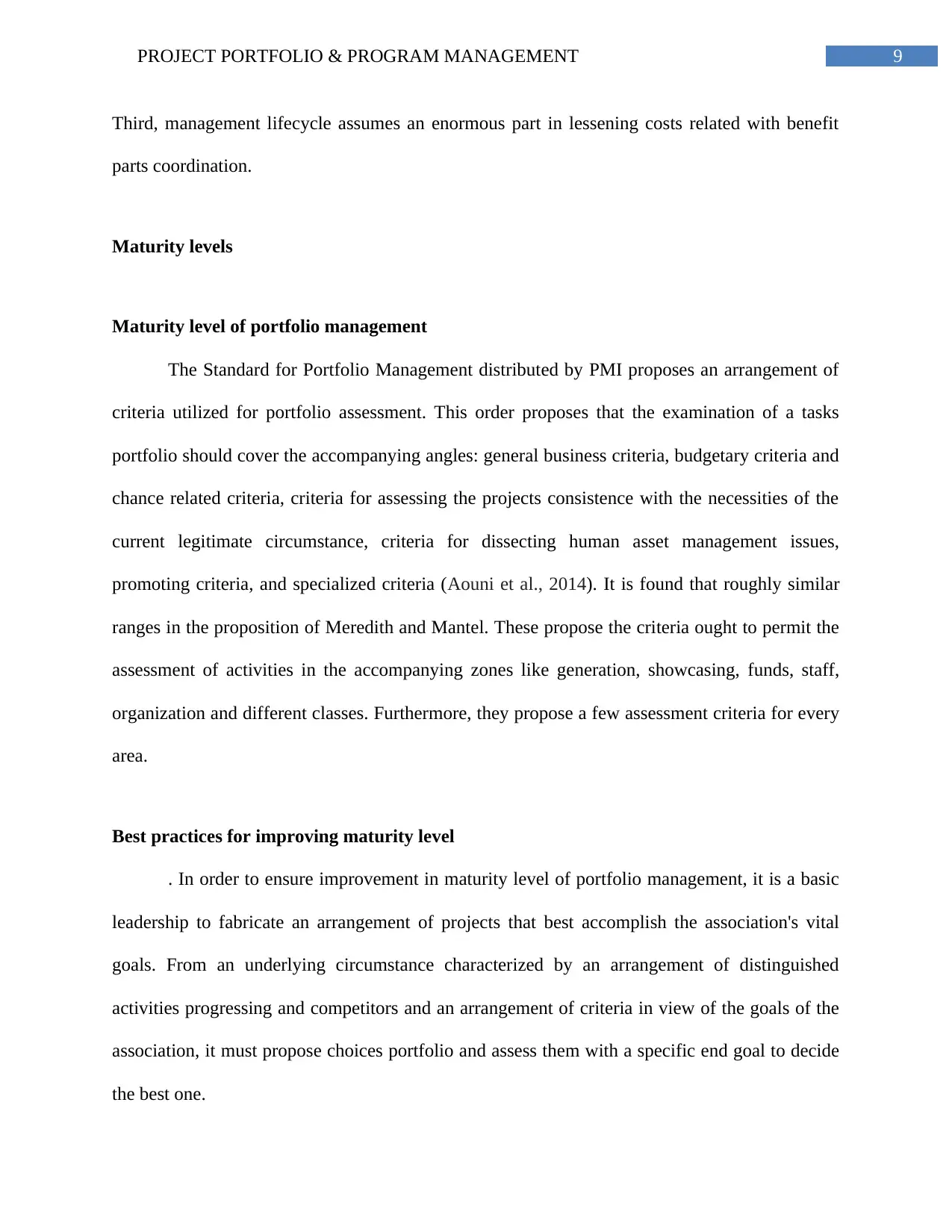
9PROJECT PORTFOLIO & PROGRAM MANAGEMENT
Third, management lifecycle assumes an enormous part in lessening costs related with benefit
parts coordination.
Maturity levels
Maturity level of portfolio management
The Standard for Portfolio Management distributed by PMI proposes an arrangement of
criteria utilized for portfolio assessment. This order proposes that the examination of a tasks
portfolio should cover the accompanying angles: general business criteria, budgetary criteria and
chance related criteria, criteria for assessing the projects consistence with the necessities of the
current legitimate circumstance, criteria for dissecting human asset management issues,
promoting criteria, and specialized criteria (Aouni et al., 2014). It is found that roughly similar
ranges in the proposition of Meredith and Mantel. These propose the criteria ought to permit the
assessment of activities in the accompanying zones like generation, showcasing, funds, staff,
organization and different classes. Furthermore, they propose a few assessment criteria for every
area.
Best practices for improving maturity level
. In order to ensure improvement in maturity level of portfolio management, it is a basic
leadership to fabricate an arrangement of projects that best accomplish the association's vital
goals. From an underlying circumstance characterized by an arrangement of distinguished
activities progressing and competitors and an arrangement of criteria in view of the goals of the
association, it must propose choices portfolio and assess them with a specific end goal to decide
the best one.
Third, management lifecycle assumes an enormous part in lessening costs related with benefit
parts coordination.
Maturity levels
Maturity level of portfolio management
The Standard for Portfolio Management distributed by PMI proposes an arrangement of
criteria utilized for portfolio assessment. This order proposes that the examination of a tasks
portfolio should cover the accompanying angles: general business criteria, budgetary criteria and
chance related criteria, criteria for assessing the projects consistence with the necessities of the
current legitimate circumstance, criteria for dissecting human asset management issues,
promoting criteria, and specialized criteria (Aouni et al., 2014). It is found that roughly similar
ranges in the proposition of Meredith and Mantel. These propose the criteria ought to permit the
assessment of activities in the accompanying zones like generation, showcasing, funds, staff,
organization and different classes. Furthermore, they propose a few assessment criteria for every
area.
Best practices for improving maturity level
. In order to ensure improvement in maturity level of portfolio management, it is a basic
leadership to fabricate an arrangement of projects that best accomplish the association's vital
goals. From an underlying circumstance characterized by an arrangement of distinguished
activities progressing and competitors and an arrangement of criteria in view of the goals of the
association, it must propose choices portfolio and assess them with a specific end goal to decide
the best one.
Secure Best Marks with AI Grader
Need help grading? Try our AI Grader for instant feedback on your assignments.
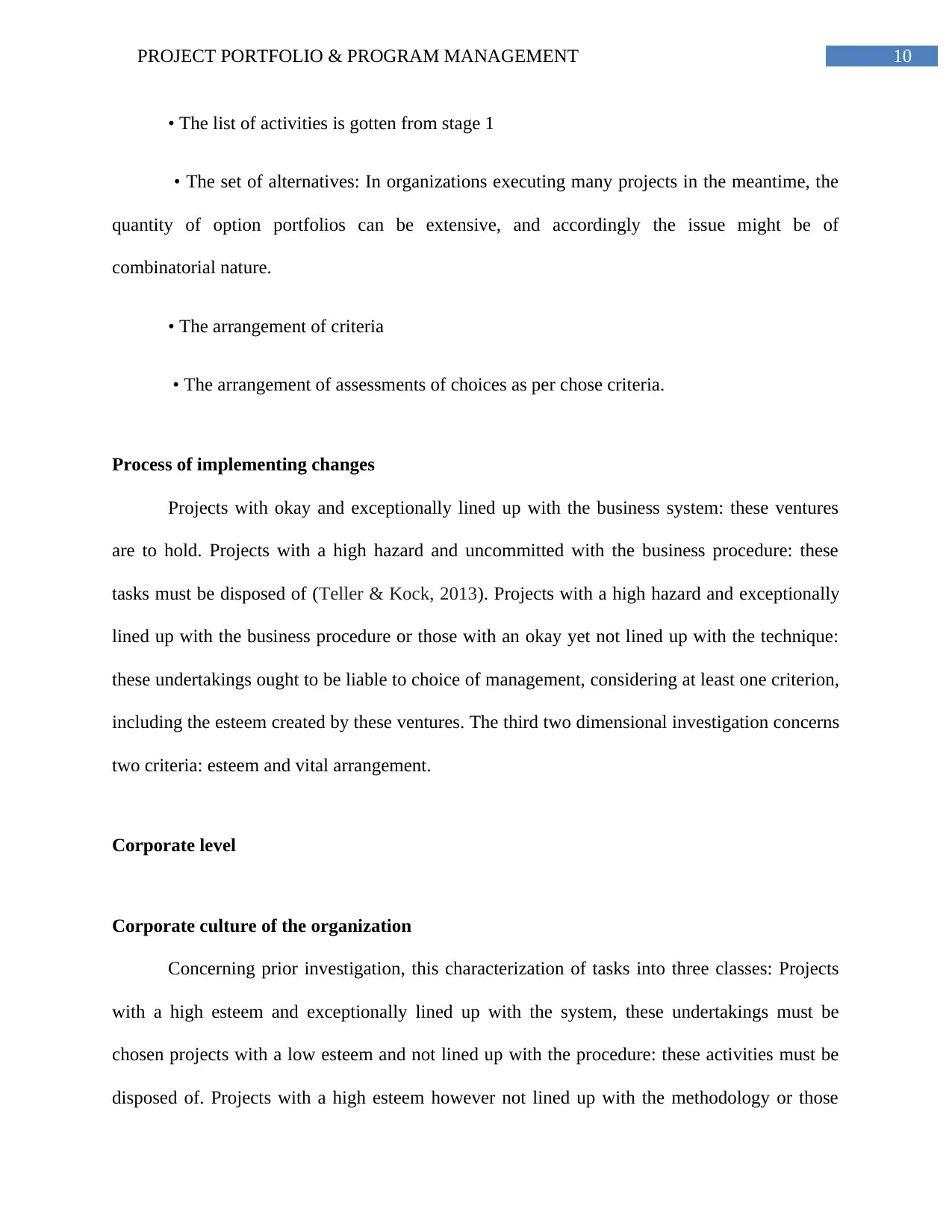
10PROJECT PORTFOLIO & PROGRAM MANAGEMENT
• The list of activities is gotten from stage 1
• The set of alternatives: In organizations executing many projects in the meantime, the
quantity of option portfolios can be extensive, and accordingly the issue might be of
combinatorial nature.
• The arrangement of criteria
• The arrangement of assessments of choices as per chose criteria.
Process of implementing changes
Projects with okay and exceptionally lined up with the business system: these ventures
are to hold. Projects with a high hazard and uncommitted with the business procedure: these
tasks must be disposed of (Teller & Kock, 2013). Projects with a high hazard and exceptionally
lined up with the business procedure or those with an okay yet not lined up with the technique:
these undertakings ought to be liable to choice of management, considering at least one criterion,
including the esteem created by these ventures. The third two dimensional investigation concerns
two criteria: esteem and vital arrangement.
Corporate level
Corporate culture of the organization
Concerning prior investigation, this characterization of tasks into three classes: Projects
with a high esteem and exceptionally lined up with the system, these undertakings must be
chosen projects with a low esteem and not lined up with the procedure: these activities must be
disposed of. Projects with a high esteem however not lined up with the methodology or those
• The list of activities is gotten from stage 1
• The set of alternatives: In organizations executing many projects in the meantime, the
quantity of option portfolios can be extensive, and accordingly the issue might be of
combinatorial nature.
• The arrangement of criteria
• The arrangement of assessments of choices as per chose criteria.
Process of implementing changes
Projects with okay and exceptionally lined up with the business system: these ventures
are to hold. Projects with a high hazard and uncommitted with the business procedure: these
tasks must be disposed of (Teller & Kock, 2013). Projects with a high hazard and exceptionally
lined up with the business procedure or those with an okay yet not lined up with the technique:
these undertakings ought to be liable to choice of management, considering at least one criterion,
including the esteem created by these ventures. The third two dimensional investigation concerns
two criteria: esteem and vital arrangement.
Corporate level
Corporate culture of the organization
Concerning prior investigation, this characterization of tasks into three classes: Projects
with a high esteem and exceptionally lined up with the system, these undertakings must be
chosen projects with a low esteem and not lined up with the procedure: these activities must be
disposed of. Projects with a high esteem however not lined up with the methodology or those
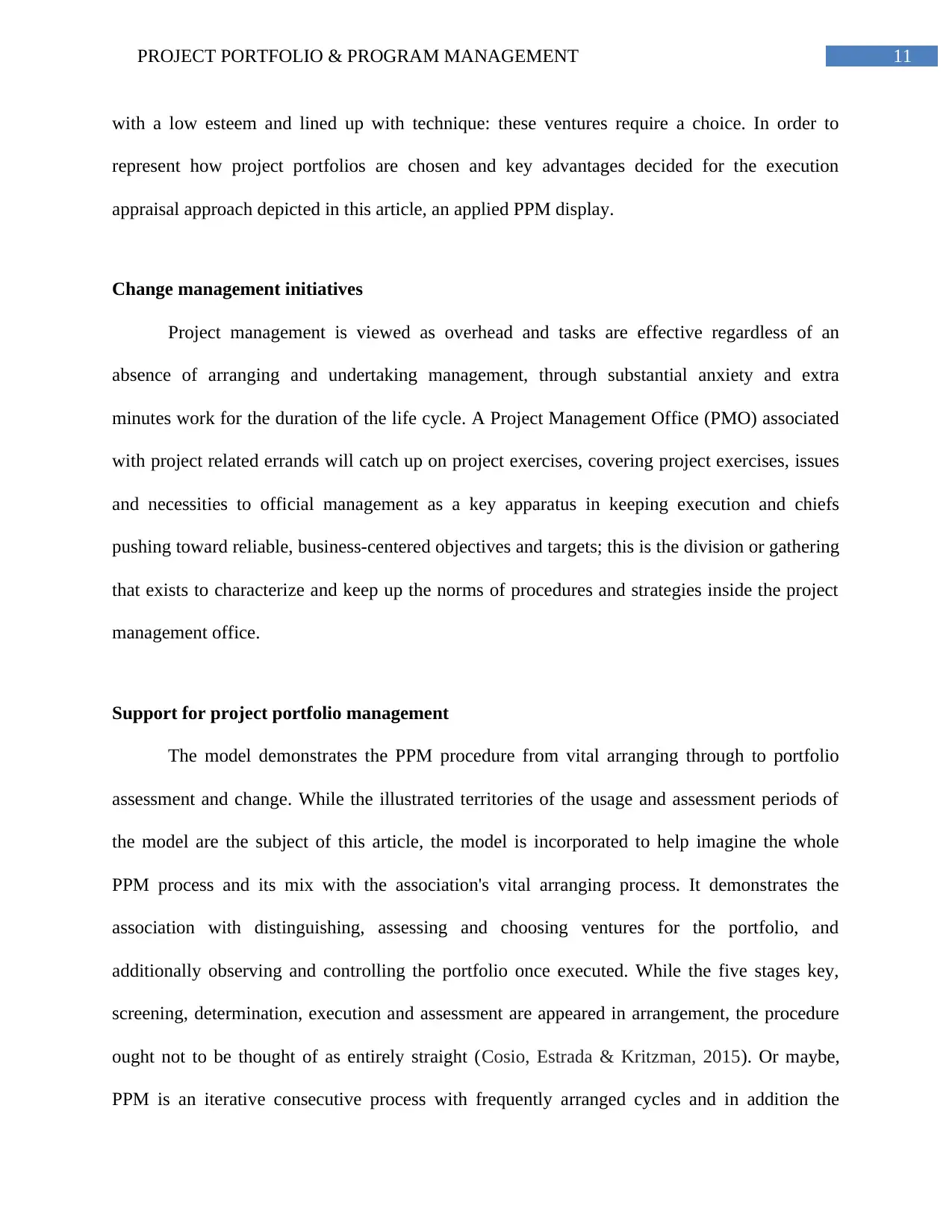
11PROJECT PORTFOLIO & PROGRAM MANAGEMENT
with a low esteem and lined up with technique: these ventures require a choice. In order to
represent how project portfolios are chosen and key advantages decided for the execution
appraisal approach depicted in this article, an applied PPM display.
Change management initiatives
Project management is viewed as overhead and tasks are effective regardless of an
absence of arranging and undertaking management, through substantial anxiety and extra
minutes work for the duration of the life cycle. A Project Management Office (PMO) associated
with project related errands will catch up on project exercises, covering project exercises, issues
and necessities to official management as a key apparatus in keeping execution and chiefs
pushing toward reliable, business-centered objectives and targets; this is the division or gathering
that exists to characterize and keep up the norms of procedures and strategies inside the project
management office.
Support for project portfolio management
The model demonstrates the PPM procedure from vital arranging through to portfolio
assessment and change. While the illustrated territories of the usage and assessment periods of
the model are the subject of this article, the model is incorporated to help imagine the whole
PPM process and its mix with the association's vital arranging process. It demonstrates the
association with distinguishing, assessing and choosing ventures for the portfolio, and
additionally observing and controlling the portfolio once executed. While the five stages key,
screening, determination, execution and assessment are appeared in arrangement, the procedure
ought not to be thought of as entirely straight (Cosio, Estrada & Kritzman, 2015). Or maybe,
PPM is an iterative consecutive process with frequently arranged cycles and in addition the
with a low esteem and lined up with technique: these ventures require a choice. In order to
represent how project portfolios are chosen and key advantages decided for the execution
appraisal approach depicted in this article, an applied PPM display.
Change management initiatives
Project management is viewed as overhead and tasks are effective regardless of an
absence of arranging and undertaking management, through substantial anxiety and extra
minutes work for the duration of the life cycle. A Project Management Office (PMO) associated
with project related errands will catch up on project exercises, covering project exercises, issues
and necessities to official management as a key apparatus in keeping execution and chiefs
pushing toward reliable, business-centered objectives and targets; this is the division or gathering
that exists to characterize and keep up the norms of procedures and strategies inside the project
management office.
Support for project portfolio management
The model demonstrates the PPM procedure from vital arranging through to portfolio
assessment and change. While the illustrated territories of the usage and assessment periods of
the model are the subject of this article, the model is incorporated to help imagine the whole
PPM process and its mix with the association's vital arranging process. It demonstrates the
association with distinguishing, assessing and choosing ventures for the portfolio, and
additionally observing and controlling the portfolio once executed. While the five stages key,
screening, determination, execution and assessment are appeared in arrangement, the procedure
ought not to be thought of as entirely straight (Cosio, Estrada & Kritzman, 2015). Or maybe,
PPM is an iterative consecutive process with frequently arranged cycles and in addition the
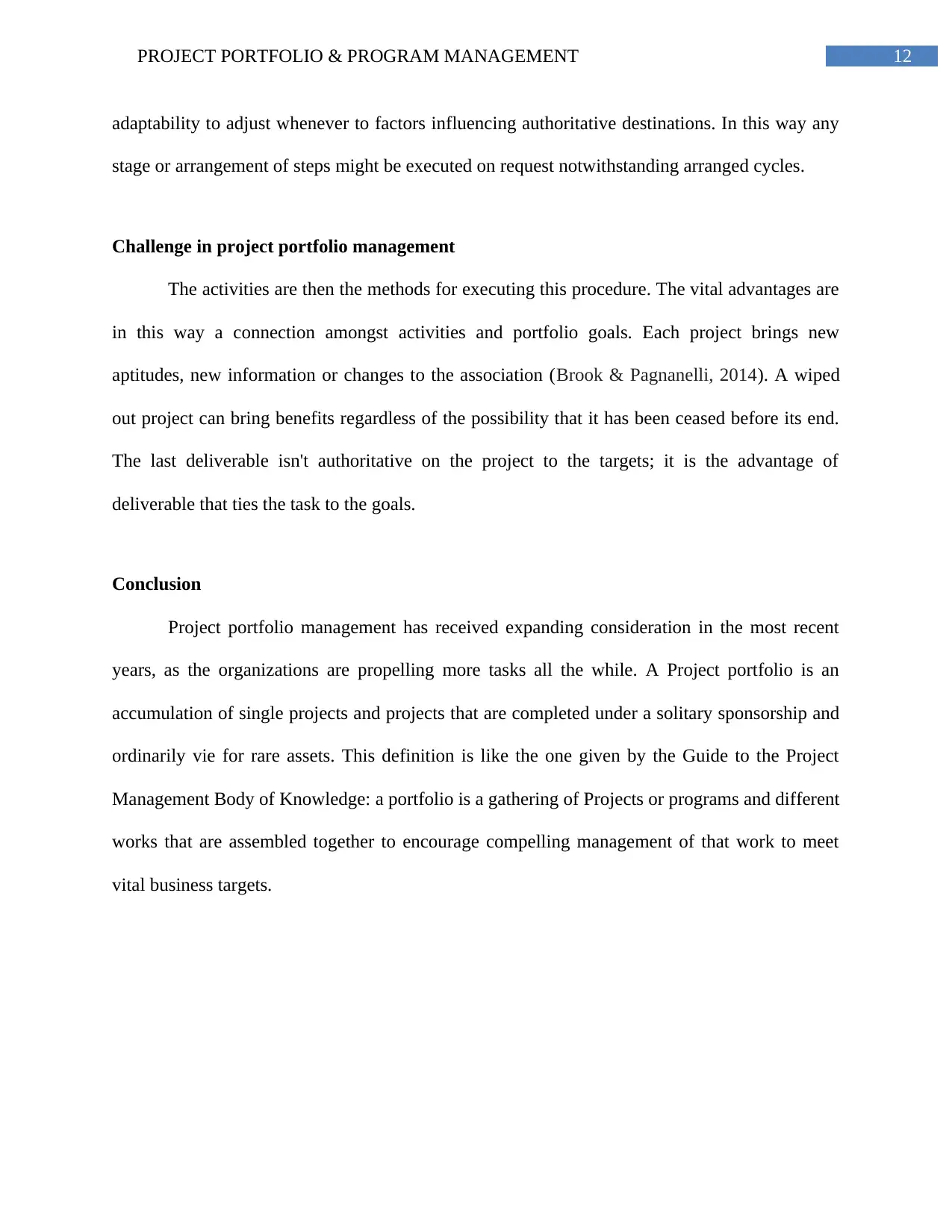
12PROJECT PORTFOLIO & PROGRAM MANAGEMENT
adaptability to adjust whenever to factors influencing authoritative destinations. In this way any
stage or arrangement of steps might be executed on request notwithstanding arranged cycles.
Challenge in project portfolio management
The activities are then the methods for executing this procedure. The vital advantages are
in this way a connection amongst activities and portfolio goals. Each project brings new
aptitudes, new information or changes to the association (Brook & Pagnanelli, 2014). A wiped
out project can bring benefits regardless of the possibility that it has been ceased before its end.
The last deliverable isn't authoritative on the project to the targets; it is the advantage of
deliverable that ties the task to the goals.
Conclusion
Project portfolio management has received expanding consideration in the most recent
years, as the organizations are propelling more tasks all the while. A Project portfolio is an
accumulation of single projects and projects that are completed under a solitary sponsorship and
ordinarily vie for rare assets. This definition is like the one given by the Guide to the Project
Management Body of Knowledge: a portfolio is a gathering of Projects or programs and different
works that are assembled together to encourage compelling management of that work to meet
vital business targets.
adaptability to adjust whenever to factors influencing authoritative destinations. In this way any
stage or arrangement of steps might be executed on request notwithstanding arranged cycles.
Challenge in project portfolio management
The activities are then the methods for executing this procedure. The vital advantages are
in this way a connection amongst activities and portfolio goals. Each project brings new
aptitudes, new information or changes to the association (Brook & Pagnanelli, 2014). A wiped
out project can bring benefits regardless of the possibility that it has been ceased before its end.
The last deliverable isn't authoritative on the project to the targets; it is the advantage of
deliverable that ties the task to the goals.
Conclusion
Project portfolio management has received expanding consideration in the most recent
years, as the organizations are propelling more tasks all the while. A Project portfolio is an
accumulation of single projects and projects that are completed under a solitary sponsorship and
ordinarily vie for rare assets. This definition is like the one given by the Guide to the Project
Management Body of Knowledge: a portfolio is a gathering of Projects or programs and different
works that are assembled together to encourage compelling management of that work to meet
vital business targets.
Paraphrase This Document
Need a fresh take? Get an instant paraphrase of this document with our AI Paraphraser
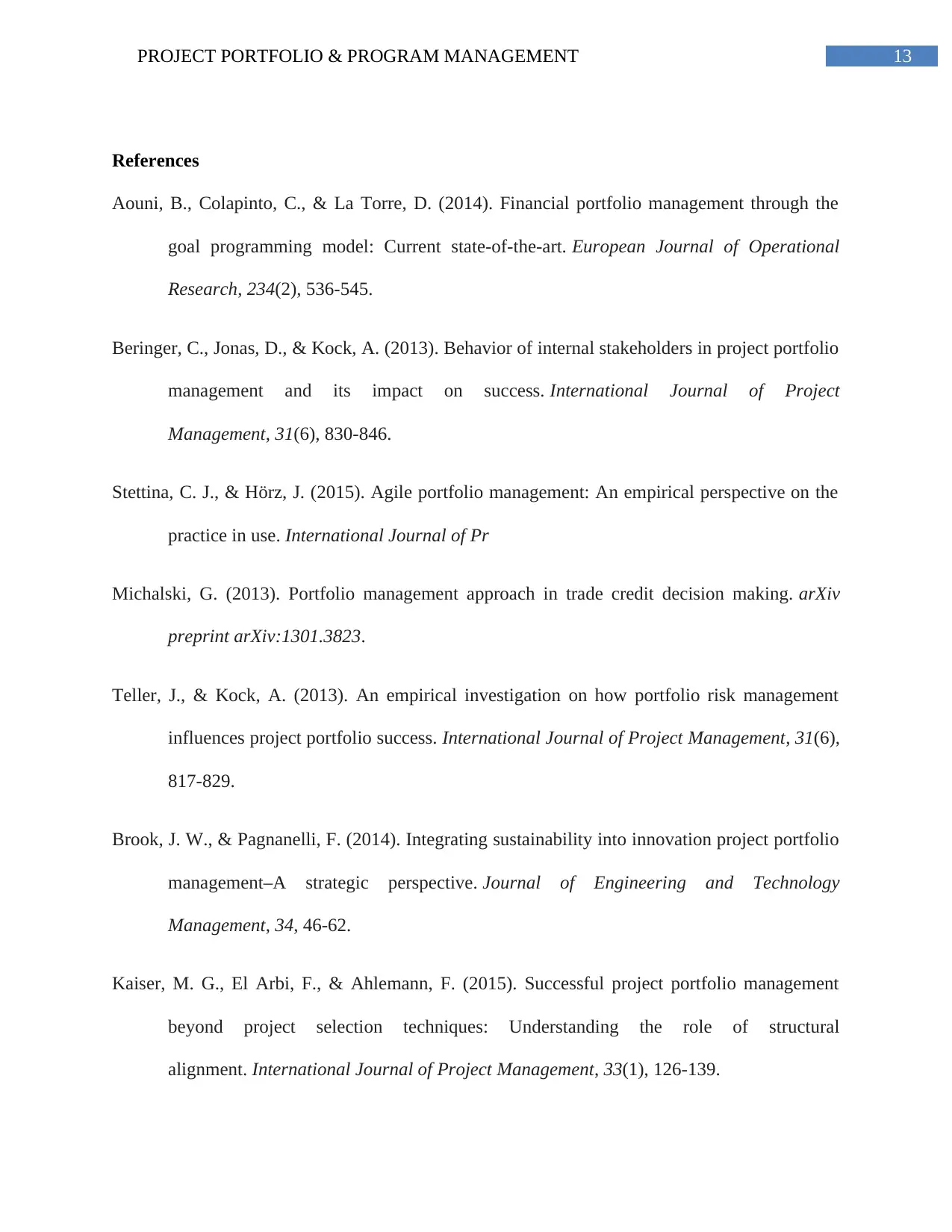
13PROJECT PORTFOLIO & PROGRAM MANAGEMENT
References
Aouni, B., Colapinto, C., & La Torre, D. (2014). Financial portfolio management through the
goal programming model: Current state-of-the-art. European Journal of Operational
Research, 234(2), 536-545.
Beringer, C., Jonas, D., & Kock, A. (2013). Behavior of internal stakeholders in project portfolio
management and its impact on success. International Journal of Project
Management, 31(6), 830-846.
Stettina, C. J., & Hörz, J. (2015). Agile portfolio management: An empirical perspective on the
practice in use. International Journal of Pr
Michalski, G. (2013). Portfolio management approach in trade credit decision making. arXiv
preprint arXiv:1301.3823.
Teller, J., & Kock, A. (2013). An empirical investigation on how portfolio risk management
influences project portfolio success. International Journal of Project Management, 31(6),
817-829.
Brook, J. W., & Pagnanelli, F. (2014). Integrating sustainability into innovation project portfolio
management–A strategic perspective. Journal of Engineering and Technology
Management, 34, 46-62.
Kaiser, M. G., El Arbi, F., & Ahlemann, F. (2015). Successful project portfolio management
beyond project selection techniques: Understanding the role of structural
alignment. International Journal of Project Management, 33(1), 126-139.
References
Aouni, B., Colapinto, C., & La Torre, D. (2014). Financial portfolio management through the
goal programming model: Current state-of-the-art. European Journal of Operational
Research, 234(2), 536-545.
Beringer, C., Jonas, D., & Kock, A. (2013). Behavior of internal stakeholders in project portfolio
management and its impact on success. International Journal of Project
Management, 31(6), 830-846.
Stettina, C. J., & Hörz, J. (2015). Agile portfolio management: An empirical perspective on the
practice in use. International Journal of Pr
Michalski, G. (2013). Portfolio management approach in trade credit decision making. arXiv
preprint arXiv:1301.3823.
Teller, J., & Kock, A. (2013). An empirical investigation on how portfolio risk management
influences project portfolio success. International Journal of Project Management, 31(6),
817-829.
Brook, J. W., & Pagnanelli, F. (2014). Integrating sustainability into innovation project portfolio
management–A strategic perspective. Journal of Engineering and Technology
Management, 34, 46-62.
Kaiser, M. G., El Arbi, F., & Ahlemann, F. (2015). Successful project portfolio management
beyond project selection techniques: Understanding the role of structural
alignment. International Journal of Project Management, 33(1), 126-139.
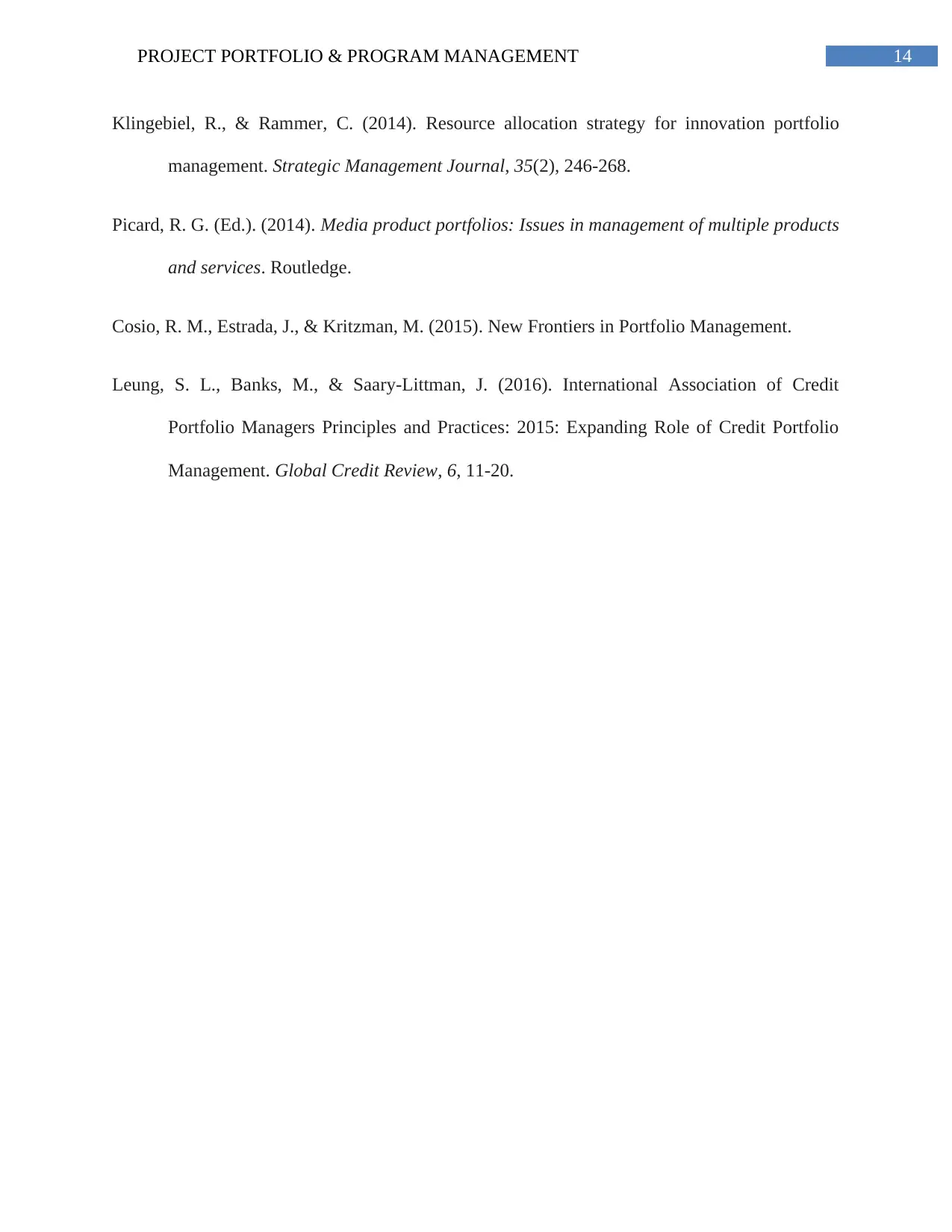
14PROJECT PORTFOLIO & PROGRAM MANAGEMENT
Klingebiel, R., & Rammer, C. (2014). Resource allocation strategy for innovation portfolio
management. Strategic Management Journal, 35(2), 246-268.
Picard, R. G. (Ed.). (2014). Media product portfolios: Issues in management of multiple products
and services. Routledge.
Cosio, R. M., Estrada, J., & Kritzman, M. (2015). New Frontiers in Portfolio Management.
Leung, S. L., Banks, M., & Saary-Littman, J. (2016). International Association of Credit
Portfolio Managers Principles and Practices: 2015: Expanding Role of Credit Portfolio
Management. Global Credit Review, 6, 11-20.
Klingebiel, R., & Rammer, C. (2014). Resource allocation strategy for innovation portfolio
management. Strategic Management Journal, 35(2), 246-268.
Picard, R. G. (Ed.). (2014). Media product portfolios: Issues in management of multiple products
and services. Routledge.
Cosio, R. M., Estrada, J., & Kritzman, M. (2015). New Frontiers in Portfolio Management.
Leung, S. L., Banks, M., & Saary-Littman, J. (2016). International Association of Credit
Portfolio Managers Principles and Practices: 2015: Expanding Role of Credit Portfolio
Management. Global Credit Review, 6, 11-20.
1 out of 15
Related Documents
Your All-in-One AI-Powered Toolkit for Academic Success.
+13062052269
info@desklib.com
Available 24*7 on WhatsApp / Email
![[object Object]](/_next/static/media/star-bottom.7253800d.svg)
Unlock your academic potential
© 2024 | Zucol Services PVT LTD | All rights reserved.




